









|
The key to the high degree of transparency between systems is the Tuxedo Mainframe Adapter for TCP Gateway (hereafter referenced as TMA TCP Gateway) configuration. Environmental differences, such as data formats, are concealed from programmers and programs through this mechanism.
This document provides information about the following topics:
This document also provides information about creating VIEW definitions. VIEW definitions are descriptions of data structures that are used for input and output in the BEA Tuxedo environment. The TMA TCP Gateway product uses VIEW definitions to determine how to convert input data and output data into formats that are acceptable to target systems.
For detailed information about updating the TMA TCP Gateway configuration files (GWICONFIG and DMCONFIG), see the
Configuring BEA TMA TCP Gateway section.
| Note: | The task of configuring data mappings could be considered a programming activity because it requires knowledge of the BEA Tuxedo programming environment. However, because configuration parameters affect many application programs, configuration is usually an administrator's responsibility. |
This section introduces procedures that TMA TCP Gateway follows to process and convert input and output data.
In this guide, the following terms are used to describe input and output data.
These terms make it easier to understand how TMA TCP Gateway handles input and output data.
The TMA TCP Gateway processes buffers from local programs in the following manner.
The TMA TCP Gateway product automatically "types" input buffers that local client programs send to remote services.
The TMA TCP Gateway product automatically "types" output buffers that local services return to remote client programs.
GWICONFIG) to determine whether the buffer needs to be converted to a different format.Client requests sent to remote services may need to be converted to record formats that are meaningful to those services.
Server responses returned to remote client programs may need to be converted to record formats that are meaningful to those programs.
The TMA TCP Gateway processes buffers from remote programs in the following manner.
GWICONFIG) to determine the record's type. DMCONFIG) to determine whether the record needs to be converted to a different format.Client requests from remote client programs may need to be converted to buffer formats that are acceptable to local service routines.
Server responses returned from remote services may need to be converted to buffer formats that are acceptable to local client programs.
The TMA TCP Gateway product provides four configuration parameters you can use to map buffers and records. For more information about buffers and records, see the Buffers and Records section.
Specify the following buffer configuration parameters in the domain configuration file (DMCONFIG).
INBUFTYPE
OUTBUFTYPE
Specify the following record configuration parameters in the gateway configuration file (GWICONFIG).
INRECTYPE
OUTRECTYPE
Each of these four parameters has two possible meanings or interpretations—one for service requests that originate locally, and one for service requests that originate on remote systems.
The following sections, Parameters for Locally Originated Calls and Parameters for Remotely Originated Calls, explore these different meanings in detail.
This section takes a closer look at how TMA TCP Gateway handles service calls that originate locally, within the immediate BEA Tuxedo region. Also, it explains how the INBUFTYPE, INRECTYPE, OUTRECTYPE, and OUTBUFTYPE parameters can be used to manage the conversion of buffers and records that flow between local client programs and remote services.
In the following figure, a local BEA Tuxedo client program issues a service call that a local TMA TCP Gateway routes to a remote server through TMA TCP Gateway.
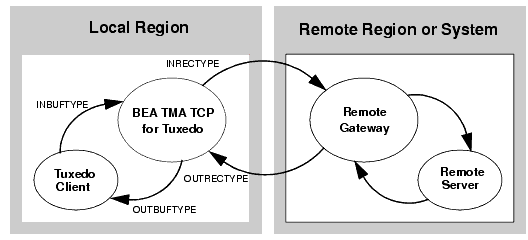
In this situation, the four configuration parameters that are shown in the figure have the following meanings:
INBUFTYPE parameter describes the BEA Tuxedo input buffer that the local client program provides to the TMA TCP Gateway through BEA Tuxedo software. INRECTYPE parameter describes the input record that is sent to the service on the remote system. OUTRECTYPE parameter describes the output record that is received from the service on the remote system.OUTBUFTYPE parameter describes the BEA Tuxedo output buffer that is returned to the local client program.
The following sections provide detailed information explaining how to use the INBUFTYPE and INRECTYPE parameters for service calls that originate locally (where local client programs call remote services).
INBUFTYPE
INBUFTYPE parameter is used to specify the request buffer type that is provided to a local TMA TCP Gateway when a local client program issues a service request.
INRECTYPE
INRECTYPE parameter is used to specify the type, and in some cases the format, of the request record that a particular remote service requires. The TMA TCP Gateway uses this information to convert BEA Tuxedo request buffers into records that remote services can process.
INRECTYPE parameter when one of the circumstances described in the following table is true.
INRECTYPE parameter may be omitted if the request buffer is identical, in type and structure, to the request record the remote service expects.
The following sections provide detailed information explaining how to use the OUTRECTYPE and OUTBUFTYPE parameters for service calls that originate locally (where local client programs call remote services and receive output from those services).
OUTBUFTYPE
OUTBUFTYPE parameter is used to specify the type, and in some cases the structure, of the reply buffer that a local client program expects. The TMA TCP Gateway uses this information to map reply records from remote services to the appropriate kinds of reply buffers.
OUTRECTYPE
OUTRECTYPE parameter is used to specify the type, and in some cases the format, of the reply record that a particular remote service returns to the local TMA TCP Gateway.
OUTRECTYPE parameter when one of the circumstances described in the following table is true.
OUTRECTYPE parameter may be omitted if the remote service returns a reply record that is identical, in type and structure, to the reply buffer the local client program expects.
This section takes a closer look at how TMA TCP Gateway handles service calls that originate on remote computers, outside the local BEA Tuxedo region. Also, it explains how the INRECTYPE, INBUFTYPE, OUTBUFTYPE, and OUTRECTYPE parameters can be used to manage the conversion of buffers and records that flow between remote client programs and local services.
In the following figure, a remote client program issues a service request that a remote TMA TCP gateway routes to the local TMA TCP Gateway. The gateway receives the request from the network and passes the request to a local BEA Tuxedo server.
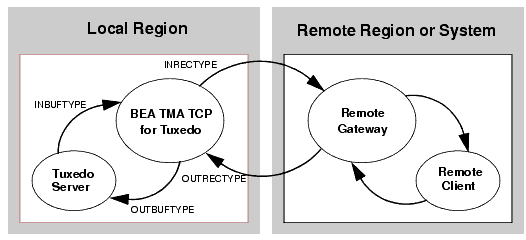
In this situation, the four configuration parameters that are shown in the figure have the following meanings:
OUTRECTYPE parameter describes the output record that the remote client sends to the TMA TCP Gateway. OUTBUFTYPE parameter describes the BEA Tuxedo output buffer that is provided to the local server. INBUFTYPE parameter describes the BEA Tuxedo input buffer that the local server returns to the TMA TCP Gateway. INRECTYPE parameter describes the input record that the local TMA TCP Gateway returns to the remote client program.
The following sections provide detailed information explaining how to use the INRECTYPE and INBUFTYPE parameters for service calls that originate on remote systems (where remote client programs call local services).
INBUFTYPE
INBUFTYPE parameter is used to specify the type, and in some cases the structure, of the reply buffer that the TMA TCP Gateway expects from a local server. The TMA TCP Gateway uses this information to map reply buffers from local server programs to the appropriate kind of reply records.
INRECTYPE
INRECTYPE parameter is used to specify the type, and in some cases the format, of the reply record that the local TMA TCP Gateway sends to the remote client.
INRECTYPE parameter when one of the circumstances described in the following table is true.
INRECTYPE parameter if the local server program sends a reply buffer that is identical in type and structure to the reply record the remote client expects.
The following sections provide detailed information explaining how to use the OUTBUFTYPE and OUTRECTYPE parameters for service calls that originate on remote computers (where remote client programs call local services and receive output from those services).
OUTBUFTYPE
OUTBUFTYPE parameter specifies the request buffer type that the local TMA TCP Gateway provides to the local server.
OUTRECTYPE
OUTRECTYPE parameter is used to specify the type, and in some cases the format, of the request record a particular remote client program sends to the TMA TCP Gateway. The TMA TCP Gateway uses this information to convert request records from remote clients into buffers that local server programs can process.
OUTRECTYPE parameter when one of the circumstances described in the following table is true.
OUTRECTYPE parameter may be omitted if the local service's request buffer is identical, in type and structure, to the request record the remote client program provides.
The following figure shows all the possibilities for mapping buffers to records. The TMA TCP Gateway is responsible for mapping buffers to records, based on information it finds in the TMA TCP Gateway configuration. This mapping occurs for Tuxedo client requests and Tuxedo server responses.
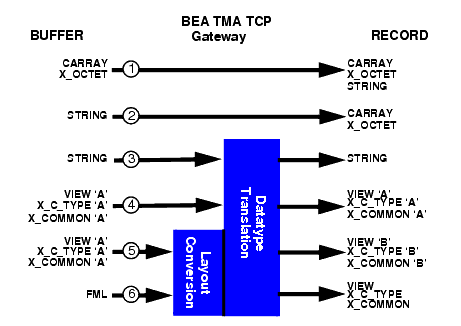
The following table lists some of the mapping possibilities that are shown in the previous figure and some suggestions for setting the INBUFTYPE and INRECTYPE parameters.
BEA Tuxedo
CARRAY input buffers can be copied to CARRAY input records. A CARRAY buffer contains raw data that is not converted or translated. Set the INBUFTYPE parameter to CARRAY, and omit the INRECTYPE parameter.
CARRAY input buffers can also be copied to STRING input records. This creates a string that goes through no conversion and no translation. The resultant buffer is the length of the original CARRAY buffer. Since all characters are copied, if the CARRAY buffer contains null characters, it affects the buffer when later handled as a STRING. The INBUFTYPE parameter should be set to CARRAY and the INRECTYPE parameter should be set to STRING.
|
|||
BEA Tuxedo
VIEW input buffers can be mapped to identical BEA Tuxedo VIEW input records. In this situation, the data structure that the remote service expects is identical to the data structure the client program uses. There is no need to create a new VIEW definition. Instead, specify the input record type (VIEW) and the name of the existing VIEW definition (the one the client program currently uses) for both the INBUFTYPE parameter, and omit the INRECTYPE parameter.
|
|||
BEA Tuxedo
VIEW input buffers can be mapped to VIEW input records—in any combination. However, in this situation, the data structure that the remote service expects (designated as VIEW `B' mapping possibilities in Figure 3-3) differs from the data structure the client program uses (designated as VIEW `A' in Figure 3-3). Consequently, you must
|
|||
Before a BEA Tuxedo FML input buffer can be sent to a remote service that does not support FML, it must be mapped to one of the following input record types:
VIEW, X_C_TYPE, or X_COMMON. Also, you must create a VIEW definition for the input data structure that the remote service expects. Set INBUFTYPE to FML and INRECTYPE to VIEW:viewname.
|
The following figure shows all the possibilities for mapping records to buffers. The TMA TCP Gateway is responsible for mapping records to buffers, based on information it finds in the TMA TCP Gateway configuration. This mapping occurs for remote client requests and remote server responses.
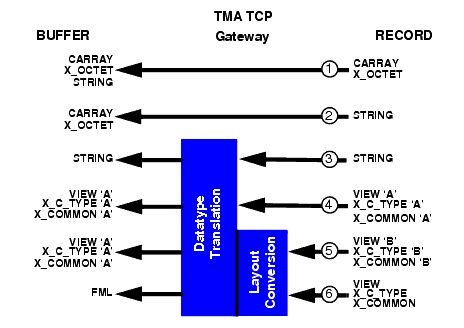
The following table lists some of the mapping possibilities that are shown in the previous figure and some suggestions for setting the OUTRECTYPE and OUTBUFTYPE parameters (for service calls that originate locally).
BEA Tuxedo
CARRAY output records can be copied to CARRAY output buffers. A CARRAY buffer contains raw data that is not converted or translated. Set the OUTBUFTYPE parameter to CARRAY. The OUTRECTYPE parameters need not be set.
BEA Tuxedo
CARRAY output records can also be copied to STRING output buffers. This creates a string that goes through no conversion and no translation. The resultant buffer is the length of the original CARRAY buffer. Since all characters are copied, if the CARRAY buffer contains null characters, it affects the buffer when later handled as a STRING. The OUTRECTYPE should be set to CARRAY and OUTBUFTYPE should be set to STRING.
|
|||
BEA Tuxedo
VIEW output records can be mapped to identical BEA Tuxedo VIEW output buffers. In this situation, the data structure that the remote service returns is identical to the data structure the local client program expects. There is no need to create a new VIEW definition. Instead, specify the VIEW buffer type and the name of the existing VIEW definition with the OUTBUFTYPE parameter. The OUTRECTYPE parameter can be set to VIEW:viewname, but it is not mandatory.
|
|||
BEA Tuxedo
VIEW output records can be mapped to VIEW output buffers—in any combination. However, in this situation, the data structure that the remote service returns (designated as VIEW `B' in Figure 3-4) differs from the data structure the client program expects (designated as VIEW `A' in Figure 3-4). To facilitate the conversion process, perform the following tasks.
|
|||
BEA Tuxedo
VIEW output records can be mapped to FML output buffers. To facilitate the conversion process, you must perform the following tasks.
|
VIEW definitions are used to describe input and output records that are sent to and received from remote systems. They describe data elements and indicate how data elements are typed and sequenced. Based on these descriptions, TMA TCP Gateway translates field data types as required to maintain transparency between dissimilar systems.
You should create VIEW definitions before you configure TMA TCP Gateway. For complete information about VIEW definitions and related topics, see the BEA Tuxedo Programmer's Guide.
The TMA TCP Gateway buffer and record conversion capabilities are extremely powerful and flexible. The key to maximizing these capabilities is to thoroughly understand the BEA Tuxedo VIEW definition mechanism.
VIEW definitions make it possible to specify composite data structures that can be used:
After determining the input and output record layouts for the remote application programs you are working with, you need to prepare VIEW definitions and specify these definitions in the configuration files.
| Note: | FML fields must be specified for all VIEWs that TMA TCP Gateway converts. In other words, any VIEW that you specify as an INRECTYPE, OUTRECTYPE, INBUFTYPE, or OUTBUFTYPE must be defined with appropriate FML fields (no dashes in the FNAME column of the VIEW definition). For the FML fields to match, you must compile these VIEWs without the -n option specified. |
VIEW definitions in files.viewc or viewc32 VIEW compiler.VIEWFILES, VIEWDIR, FIELDTBLS, and FLDTBLDIR environment variables, using a BEA Tuxedo ENVFILE if necessary (so that TMA TCP Gateway servers can locate binary VIEW files and field table files at runtime).VIEW definitions in the GWICONFIG and DMCONFIG files (by associating names of VIEW definitions with the INRECTYPE, OUTRECTYPE, INBUFTYPE, and OUTBUFTYPE parameters, as required).For detailed information about configuring TMA TCP Gateway, see the Configuring BEA TMA TCP Gateway section.
When a local client program sends data to (or receives data from) a service routine on a different kind of computer, TMA TCP Gateway automatically translates data as required. Translation involves changing the representation of intrinsic data types by changing attributes such as word length and byte order.
The TMA TCP Gateway automatically translates input and output data as required, following rules that are described in the following section. Read the information carefully before you create VIEW definitions (to facilitate buffer conversion) and configure TMA TCP Gateway.
Basic rules for how TMA TCP Gateway translates data are described in the following subsection. For detailed information about how TMA TCP Gateway handles string and numeric data, refer to the NULL Characters in String Length Calculations (C Programs) section.
The following information outlines the data translation rules that TMA TCP Gateway follows:
CARRAY fields are passed untranslated as sequences of bytes.STRING and CHAR fields undergo ASCII-to-EBCDIC translation, if needed.SHORT and LONG fields are translated to S9(4) COMP and S9(9) COMP, respectively.FLOAT and DOUBLE fields translate to COMP-1 and COMP-2, respectively.| WARNING: | dec_t cannot be used with VIEW translations. |
| Note: | BEA Tuxedo provides a field type named dec_t that supports decimal values within VIEWs. The TMA TCP Gateway translates these fields into machine independent representations of packed decimals. For example, dec_t(m,n) becomes S9(2*m-(n+1))V9(n) COMP-3. Therefore, a decimal field with a size of 8,5 corresponds to S9(10)V9(5) COMP-3. |
The following table summarizes the relationships.
When you create VIEW definitions for input and output buffers that are used by C language applications, you must specify extra characters for terminating NULL characters that are used in string fields.
For example, when a local application program expects a 10-byte string in an output buffer, you would specify 11 for that field—10 for the string plus 1 for the terminating NULL character.
When you create VIEW definitions for input and output buffers that are used by COBOL language applications, do not specify extra characters for terminating NULL characters that are used in string fields.
For example, when a remote COBOL application program expects 10 characters in an input record, you would specify 10 for that field, not 10 plus 1 (for the terminating NULL character).
| Note: | Although TMA TCP Gateway does not require strings to be NULL-terminated, it respects NULL termination. Therefore, when TMA TCP Gateway detects a NULL (zero) character within a string, it does not process any subsequent characters. To pass full 8-bit data that contains embedded NULL values, use a CARRAY type field or buffer. |
The TMA TCP Gateway product provides standard character translation from ASCII-to-EBCDIC and EBCDIC-to-ASCII. TMA TCP Gateway automatically performs this translation on the STRING data type.
Numeric data can easily be converted into different data types, provided that you have enough range in the intermediate and destination types to handle the maximum value you need to represent.
For example, you can convert numeric values into strings (and the reverse). For example, while FML buffers do not directly support the dec_t type, you can place decimal values in STRING fields and map these to dec_t fields within VIEW definitions.
An additional encoding library, ConvMVSC, has been included for Tuxedo clients using COBOL data types. This library, ConvMVSC, is similar to the default library, ConvMVS, but differs in the following ways:
STRING data type, both ConvMVSC and ConvMVS perform ASCII-to-EBCDIC and EBCDIC-to-ASCII translation. ConvMVS library performs EBCDIC-to-ASCII translation, truncates any trailing space characters and adds a NULL terminator. The ConvMVSC library performs the translation, but does not truncate spaces or add the terminator.VIEW data type, the ConvMVS and ConvMVSC libraries treat all field types except STRING the same. STRING fields within a view sent to a remote gateway, ConvMVS performs ASCII-to-EBCDIC conversion and appends space to `pad' the string with space characters to the size of the field. ConvMVSC performs the character conversion, but does not perform any `padding'. STRING fields within a view received from a remote gateway, ConvMVS performs EBCDIC-to-ASCII conversion, truncates any trailing space characters, and adds a NULL terminator. The ConvMVSC library performs the character conversion, but does not truncate spaces or add the terminator.There are two methods for enabling the COBOL data encoding library:
To enable COBOL data encoding for every service in the gateway, set the parameter DFLTTYPE="MVSC" in the GLOBAL section of the GWICONFIG file.
*GLOBAL
DFLTTYPE="MVSC"
To enable COBOL data encoding for messages to and from a specific host, set the parameter TYPE="MVSC" for that hosts FOREIGN entry in the GWICONFIG file.
*FOREIGN
HOST_NAME
TYPE="MVSC"
The TMA TCP software includes translation tables which enable conversions of single byte character sets (SBCS) between ASCII and EBCDIC. These tables are based on IBM-defined code sets and include the default Tuxedo code page, which is the default code page translation table used in previous releases of TMA TCP.
Each translation table consists of two mapping tables, one for outbound conversions (Tuxedo to mainframe) and one for inbound conversions (mainframe to Tuxedo). You do not have to specify the direction of a translation; however, you must determine the national language in which the host application is written. The following figure illustrates code page translation.
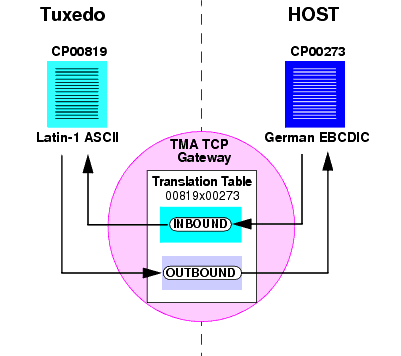
The figure demonstrates how a Tuxedo application using the Latin-1 ASCII code page CP-00819 character set operates with a host application using German EBCDIC code page CP-00273. The TMA TCP translation table 00819x00273 provides both the inbound and outbound conversions.
To designate the translation table for your applications, make an entry in the DMCONFIG file definition for each remote domain. Use the CODEPAGE parameter in the DM_REMOTE_DOMAINS section of the DMCONFIG file. Specify the translation table to use.
To specify a default code page translation for remote hosts to use, specify the translation table filename in the CODEPAGE parameter for the local gateway entry in the DM_LOCAL_DOMAINS section of the DMCONFIG file.
The following table lists the translation tables provided with the TMA TCP software.
| Note: | The Tuxedo default ASCII and EBCDIC code pages differ slightly from CP-00819 and CP-00037. |
At start up, the TMA TCP Gateway loads a translation table for each remote domain.
You can modify any of the tables to suit your application translation needs, except the default Tuxedo tables, which are hard-coded. You must restart the gateway to change any translation table definitions. The TMA TCP translation tables are located in $TUXDIR/udataobj/codepage. For table contents, refer to the
Code Page Translation Tables section.
If no CODEPAGE specification is made for a remote domain, the TMA TCP Gateway software uses the Tuxedo default translation tables.
| Note: | Copies of the default Tuxedo translation tables are included with your product software in $TUXDIR/udataobj/codepage. These copies are provided for you to apply modifications if necessary for your applications. These copies are not the actual default tables used by the gateway. You cannot modify the default Tuxedo tables because they are hard-coded. |
The following information assists you in resolving errors associated with translation tables that cause the gateway to fail. The gateway issues the following message when encountering an error associated with the specified translation table.
1072:ERROR Cannot read CODEPAGE <filename> for <LOCAL | REMOTE> DOMAIN <domainname>
For a description of error messages, refer to the Error and Information Messages section. The following causes may be responsible for the gateway issuing the previous error.
Verify that you specified the correct codepage name in the CODEPAGE parameter in the DM_REMOTE_DOMAIN section of the DMCONFIG file and that the file resides in $TUXDIR/udataobj/codepage.
Verify that the file name specified for the CODEPAGE parameter is valid. Also, verify that the specified file is not corrupt.
Verify that the specified translation table file in the $TUXDIR/udataobj/codepage directory has read permissions.
The following listing shows entries defining one local domain (CIXA) and two remote domains (CISA and IMSA). In the following example, it is assumed that the local domain uses ASCII code page CP-00819 and the two remote domains use the German and French EBCDIC code pages CP-00273 and CP-00297, respectively.
# DMCONFIG
*DM_LOCAL_DOMAINS
CIXA
TYPE=IDOMAIN
*DM_REMOTE_DOMAINS
CISA
TYPE=IDOMAIN
CODEPAGE=00819X00273
IMSA
TYPE=IDOMAIN
CODEPAGE="00819X00297"


|